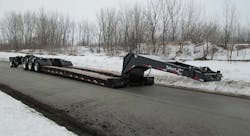When paired with the East Coast-style E2Nitro spreader, the 60CC/55SA-LD trailer from Talbert Manufacturing boasts a 60-ton capacity with a close-coupled configuration, or a 55-ton hauling capacity with a spread axle configuration.
Talbert, which specializes in heavy-haul solutions, says the trailer’s versatile design gives customers flexibility to switch between configurations to meet differing hauling regulations. While maintaining a 60-ton rating at half the deck length, the 60CC/55SA-LD offers a 6-inch ground clearance with an 18-inch loaded deck height—2 inches lower than competitive models.
“We’re the only manufacturer offering a trailer in this hauling class with an 18-inch loaded deck height,” said Troy Geisler, Talbert vice president of sales and marketing. “Those 2 inches make a huge difference in today’s hauling world.”
The Talbert 60CC/55SA-LD is a hydraulic detachable gooseneck trailer with a non-ground bearing hydraulic gooseneck design, 108-inch swing radius, 26-foot deck length and 8-foot, 6-inch deck width. The trailer is made of heavy-duty T-1, 100,000-psi minimum yield steel for durability and longevity, and comes standard with Valspar R-Cure 800 paint to prevent corrosion, which Talbert says offers a long-lasting finish.
The E2Nitro spreader, which enables the 60-ton capacity, uses a combination of hydraulic fluid and nitrogen to equalize axle pressures, providing proportionate weight distribution of each axle grouping. This optimizes the range of suspension movement, Talbert said, minimizing stress and providing a smooth ride.
In addition, the E2Nitro features a bearing pivot and pivot lockout for backing the trailer. Users also can hydraulically lock in axle loads regardless of terrain. The E2Nitro comes standard with two-speed dual landing gear for optimal stability when disconnected from the trailer.
“As loads get heavier and heavier, and our customers expand their operating territories to cover more states, there’s greater demand for trailers that meet requirements in a variety of locations,” Geisler said. “We saw more customers having the need for 3+1 in applications where the four wasn’t allowed. We’ve eliminated that hassle and the extra expense of another trailer while giving our customers additional versatility.”
